

When Maruti Suzuki launched the Swift in 2005, little did India know that this compact hatchback would go on to capture the hearts of millions across the country. Over the years, the Maruti Swift has not just evolved in design and technology but has also become synonymous with affordability, reliability, and style. The Swift isn’t just a car; it’s a symbol of aspiration and achievement for the Indian middle class.
In the mid-2000s, India’s automotive market was buzzing with competition, yet there was a gap—an affordable yet stylish car that appealed to young urbanites. Maruti Suzuki, already a household name, decided to fill this void with the Swift. The first-generation Swift, with its bold design and peppy engine, immediately struck a chord with Indian buyers. It was compact, easy to maneuver in crowded city streets, and packed with features that appealed to a younger audience.
The first Swift was a game-changer. It introduced Indian drivers to a new standard of driving dynamics and performance in a hatchback. The 1.3-liter petrol engine delivered a balance of power and fuel efficiency that quickly made it a favorite among city dwellers. Its sporty looks, combined with Maruti’s trusted reliability, meant it was an instant hit. The car’s success was further bolstered by its competitive pricing, making it an irresistible choice for first-time car buyers.
By the time the second-generation Swift arrived, the hatchback segment in India had become more competitive. But Maruti was ready. The new Swift was more refined, featuring an updated design, better interiors, and enhanced safety features. It was during this period that the Swift solidified its reputation as a car that offered more for less. The improved 1.2-liter K-series engine provided a smoother ride, while the diesel variant became a favorite for its impressive mileage.
The latest iteration of the Swift took everything that was loved about the previous models and dialed it up. With a sleeker design, advanced features like a touchscreen infotainment system, and improved safety standards, the third-generation Swift caters to the needs of modern drivers. The introduction of hybrid technology and the option of an automatic transmission further broadened its appeal. Despite these upgrades, Maruti managed to keep the Swift competitively priced, ensuring it remained a top choice in the market.
The Maruti Swift did more than just sell millions of units; it transformed the way Indians perceived hatchbacks. Before the Swift, hatchbacks were seen as basic, no-frills vehicles. The Swift, with its stylish design and feature-rich interiors, elevated the hatchback to a status symbol. It showed that small cars could be as desirable as their larger counterparts. This shift in perception forced other manufacturers to step up their game, leading to a more vibrant and competitive market.
Beyond its commercial success, the Swift has woven itself into the fabric of Indian society. From being the first car for countless families to becoming a popular choice for modifications among car enthusiasts, the Swift has touched lives in more ways than one. Its appearances in Bollywood movies and its use as a trusted vehicle by delivery services and ride-hailing companies further cement its iconic status. The Swift isn’t just a car; it’s a part of India’s automotive culture.
The Maruti Swift’s journey over the last two decades is a testament to Maruti Suzuki’s ability to understand and cater to the needs of Indian consumers. Each new generation of the Swift has built on the success of its predecessor, introducing innovations that keep the car relevant in a rapidly changing market. The Swift has not just survived; it has thrived, evolving from a promising newcomer to an enduring legend on Indian roads.
In the final statement, the Maruti Swift’s continued popularity is no accident; it’s the result of consistent innovation, a deep understanding of consumer needs, and a commitment to delivering value. As the Swift continues to evolve, it remains a car that’s not just driven but loved by millions across India.
Also Read: